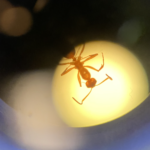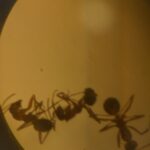Sample information |
|
| Picture |

|
|---|---|
| Location | |
| Collection date | 09/10/2024 |
| Captive / Cultivated? | Wild-caught |
| Group | Bluegrass Community and Technical College |
| Observations | The specimen was discovered feeding on my leg. It was gently swatted and preserved in 70% alcohol until analysis. The specimen was identified as an Aedes mosquito using the iNaturalist app. |
| Putative identification | Arthropoda Insecta Diptera Culicidae Aedes |
Methods |
|
| Extraction kit | DNeasy (Qiagen) blood and tissue kit |
| DNA extraction location | Whole arthropod |
| Single or Duplex PCR | Single Reaction |
| Gel electrophoresis system | Standard electrophoresis system |
| Buffer | TAE |
| DNA stain | Ethidium Bromide |
| Gel images |

|
| Protocol notes | GoTaqGreen polymerase was used for the PCR. Reaction conditions were per Lab 3: PCR (Wolbachia Project Guide) for single reaction PCRs (separate reactions were run with the Wolbachia primers and the cytochrome oxidase primers). The PCR reaction volume was 25 uL. 5 uL of each reaction was run on a 2% agarose gel. The relevant lanes, lanes 4 and 5, for the specimen (#26) are boxed. |
Results |
|
| Wolbachia presence | No |
| Confidence level | High |
| Explanation of confidence level | No PCR product was obtained in the reaction using the Wolbachia primers (WO, Lane 4), while the reaction using the cytochrome oxidase 1 (CO, Lane 5) produced a ~700 bp product, which is the correct size for the CO1 product, indicating the DNA isolated from the specimen is of suitable quality for PCR. All control reactions (Lanes 10 through 15) worked as they should. The positive control is DNA extracted from a control insect infected with Wolbachia, while the negative control is DNA extracted from an uninfected insect. Both controls were provided by the Wolbachia Project. |
| Wolbachia 16S sequence |
The PCR product was not sequenced.
BLAST at The Wolbachia Project BLAST at NCBI
|
| Arthropod COI sequence |
The PCR product was not sequenced.
BLAST at The Wolbachia Project BLAST at NCBI
|
| Summary | The Aedes was found to be negative for Wolbachia. |
 Formica Pallidefulva
Formica Pallidefulva Formica Pallidefulva
Formica Pallidefulva Ant
Ant Differential Grasshopper – Melanoplus differentialis
Differential Grasshopper – Melanoplus differentialis Pill Bug (Armadillidium vulgare) – Draft
Pill Bug (Armadillidium vulgare) – Draft